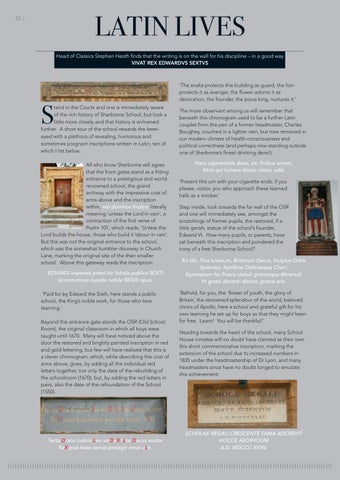LATIN LIVES
70 |
Head of Classics Stephen Heath finds that the writing is on the wall for his discipline – in a good way VIVAT REX EDWARDVS SEXTVS
S
tand in the Courts and one is immediately aware of the rich history of Sherborne School, but look a little more closely and that history is enlivened further. A short tour of the school rewards the keeneyed with a plethora of revealing, humorous and sometimes poignant inscriptions written in Latin, ten of which I list below.
All who know Sherborne will agree that the front gates stand as a fitting entrance to a prestigious and worldrenowned school, the grand archway with the impressive coat of arms above and the inscription within, nisi dominus frustra, literally meaning ‘unless the Lord in vain’, a contraction of the first verse of Psalm 107, which reads: ‘Unless the Lord builds the house, those who build it labour in vain’. But this was not the original entrance to the school, which was the somewhat humbler doorway in Church Lane, marking the original site of the then smaller school. Above this gateway reads the inscription: EDVARDI impensis patet hic Schola publica SEXTI Grammaticae cupidis nobile REGIS opus. ‘Paid for by Edward the Sixth, here stands a public school, the King’s noble work, for those who love learning.’ Beyond this entrance gate stands the OSR (Old School Room), the original classroom in which all boys were taught until 1670. Many will have noticed above the door the restored and brightly painted inscription in red and gold lettering, but few will have realised that this is a clever chronogram, which, while describing the coat of arms above, gives, by adding all the individual red letters together, not only the date of the rebuilding of the schoolroom (1670), but, by adding the red letters in pairs, also the date of the refoundation of the School (1550).
Tecta Draco custos Leo vinDeX fLos Decus auctor ReX pius haec servat protegit ornat aLit.
‘The snake protects this building as guard, the lion protects it as avenger, the flower adorns it as decoration, the founder, the pious king, nurtures it.’ The more observant among us will remember that beneath this chronogram used to be a further Latin couplet from the pen of a former headmaster, Charles Boughey, couched in a lighter vein, but now removed in our modern climate of health-consciousness and political correctness (and perhaps now standing outside one of Sherborne’s finest drinking dens!): Hanc cigarettanis dona, sis, finibus urnam, Atria qui fumans docta, viator, adis. ‘Present this urn with your cigarette ends, if you please, visitor, you who approach these learned halls as a smoker.’ Step inside, look towards the far wall of the OSR and one will immediately see, amongst the scratchings of former pupils, the restored, if a little garish, statue of the school’s founder, Edward VI. How many pupils, or parents, have sat beneath this inscription and pondered the irony of a free Sherborne School? En tibi, Flos Iuvenum, Britonum Decus, Inclytus Orbis Splendor, Apollinei Deliciaeque Chori, Gymnasium hic Pueris statuit gratumque Minerval, Vt gratis discant: discito: gratus eris. ’Behold, for you, the flower of youth, the glory of Britain, the renowned splendour of the world, beloved choirs of Apollo, here a school and grateful gift for his own learning he set up for boys so that they might learn for free. Learn! You will be thankful!’ Heading towards the heart of the school, many School House inmates will no doubt have claimed as their own this short commemorative inscription, marking the extension of the school due to increased numbers in 1835 under the headmastership of Dr Lyon, and many headmasters since have no doubt longed to emulate this achievement:
SCHOLAE REGALI CRESCENTE FAMA ADCREVIT HOCCE AEDIFICIUM A.D. MDCCC XXXV.
